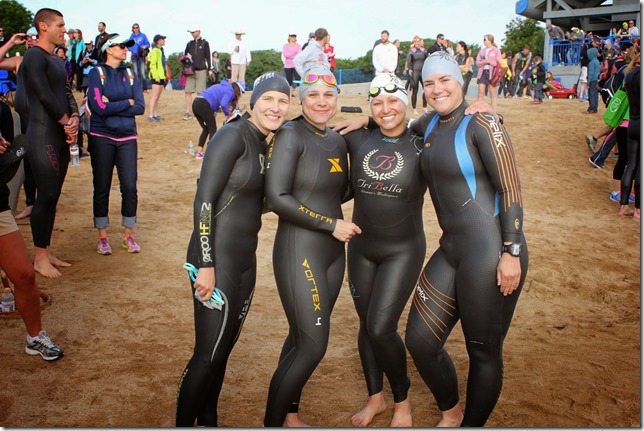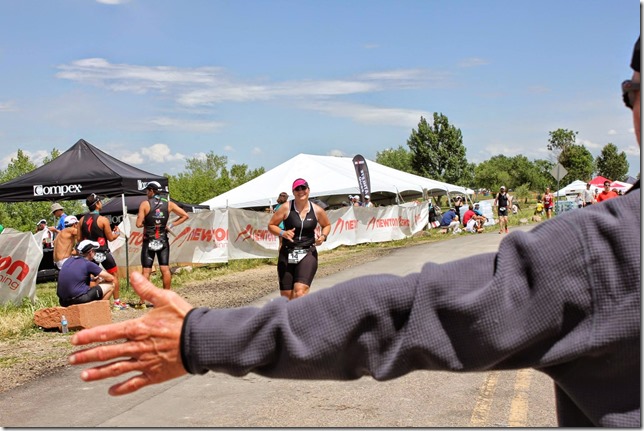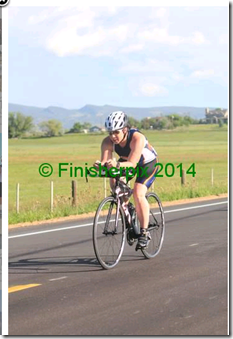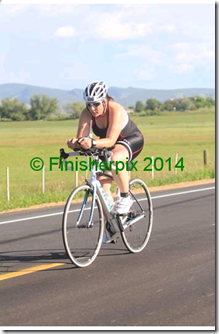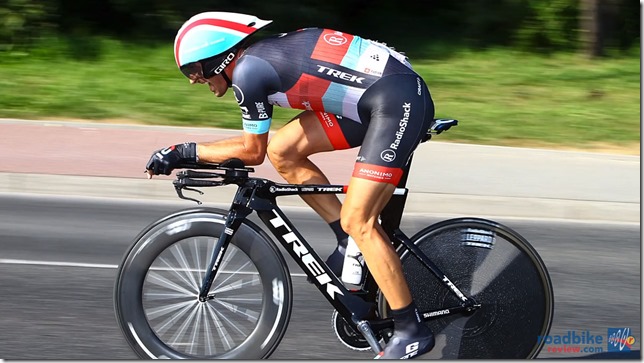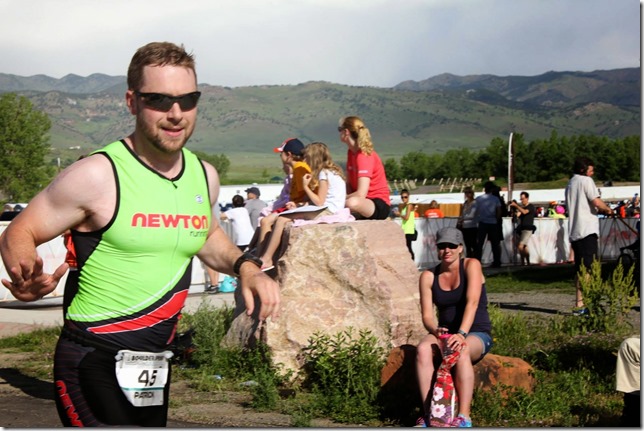Where to buy stuff
If you live in the greater Denver area then you have a plethora of triathlon, cycle, and running shops at your disposal. I have had a bunch of experience with a lot of these places and I have formulated some rankings based on my own experiences and the experiences of my friends. The places I mention I am comfortable recommending based on my experience for the things I recommend them for. I don’t take this lightly because in a lot of cases you are looking to spend good money for things so I want your experience to be a positive one.
Denver Area Cycle Shop
Top Recommendation: Wheat Ridge Cyclery
Website: http://ridewrc.com/
I recommend this shop because in my opinion it is the best shop in Denver and one of the best in the country. They carry a full line of road, tri, CX, and mountain bikes. They carry Specialized, Trek, Cervelo, Orbea, Santa Cruz, and Yeti bicycles. There service department is also best in class. Get there early on the weekend to be taken care of in a reasonable amount of time because they get busy. If you want to buy, or already own, a Specialized or a Trek – this is the shop for you. This is the only place I would recommend if you want to buy a Trek triathlon or time trial bike. This is also one of the few local sellers of Enve Composites wheelsets and components if that is your preference. Check out there demo bikes and wheels which they rent at reasonable prices.
Honorable Mention: Bicycle Village
Website: http://bicyclevillage.com/
Bicycle Village earns a honorable mention because they have a large selection of bicycles, many locations to choose from, and a fairly good service department. If you need a tube, tire, or some component this is a great place to get it. They are a large Trek reseller as well as some other brands you may be interested in like Bianchi and Fuji. There service department is honest and competent. I had a component upgrade done last year and it was perfectly done. They fall behind WRC because their selection of triathlon bikes is very limited and their selection of high end current year road bikes is somewhat low.
Denver Area Triathlon Shop
Top Recommendation: Colorado Multisport
Website: Coloradomultisport.com
Colorado Multisport earns top marks for there wide selection of triathlon apparel (they are the only local DeSoto shop) and the ability to do a Retul fit. They sell BlueSeventy and Orca wetsuits (two of the most popular brands) and they focus on Specialized and Cervelo triathlon bikes. They also sell all the popular fuels like Bonk Breaker, EFS, Osmo for Women, Gu, Powergel, Skratch, and Powerbar Ironman Perform. The staff is friendly and knowledgeable and willing to help both veterans and newbies.
Honorable Mention: Endurance House Westminster
Website: www.endurancehousewestminster.com
Endurance House earns a honorable mention based on their huge selection of running and triathlon shoes – something CMS doesn’t even offer – which includes complementary gait analysis. The owner, Jim, comes from a running background and it shows. This is also the place for people in north Denver to go if you want a Fuji or Quintana Roo triathlon bicycle which are more price friendly competitors to the Cervelo P series, the Trek Speed Concept, and the Specialized Shiv triathlon bicycles. E-House offers Orca and Zoot wetsuits for purchase or rental. They also offer race wheels by HED and Zipp for rental or purchase. Rentals include the cassette swap and brake pad replacement.
There are a few fine places that failed to make the list. For example, Kompetitive Edge is a fine shop but I normally don’t recommend places that only sell one brand or a limited selection of brands. For example, KE only sells Newton running shoes, which is great if you want Newtons. However, in order to really be a complete shop you would need to include Brooks, Pearl Izumi, Saucony, and New Balance. They primarily sell profile designs accessories which is fine if that is what you want/need, but there are other brands. KE also seems to lack any special feature that would drive people to its location. CMS has the retul fit system and E-House has its huge selection of shoes.
Leave a comment if I left someplace or something out and if it is valid I will update the list.
Triathlon Vocabulary
Last night on my drive home from work NPR had a segment about lexicon used in specific industries. The featured phrase was an “Uncle Bob”, if you are a wedding photographer an Uncle Bob is a friend or relative that brings all of his expensive camera stuff to the wedding and gets in the way of the professional.
This got me thinking, I had posted on facebook that my “tramp stamp hurt” with a #triathleteproblems which immediately made sense to my coach and some others. My coworkers who are friends with me on Facebook thought I had actually gone out and got a lower back tattoo. I had to explain that a “tramp stamp” in this context is the lower back sunburn you get from cycling in triathlon gear. The shorts have a tendency to ride low and the tops have a tendency to ride up exposing a strip of your lower back to the sun. Normally I remember to put some sunscreen on this part of my back to avoid this problem. At the 70.3 on Sunday, I sunscreened everything but that and sure enough I have a tramp stamp on my back ![]() .
.
Boulder Ironman 70.3 Race Report
I swam well, I biked well, I blew up on the run, I finished. Everything after this can be summarized exactly like that. I am extremely happy that I have completed this 70.3 because it represents 7 months of my life that have been more or less dedicated to this cause. In order to appreciate the magnitude of the change in my lifestyle that I went through we should compare where I was in October/November of 2013 and where I am now. In October I could not run two miles without stopping. In October I could not swim more than 300 meters without stopping. In October I averaged about 15 mph when I was on my road bike. I am about 25-30 pounds lighter now than I was then. I can run 13.1 miles without stopping (fresh that is, we will get to that later), I can swim 1900-2000 meters without stopping, and I ride the bike at 20-21 mph.
There were some key milestones along the way:
January – 10K, longest run
April – 13.1 miles, longest run
May – 70 miles, longest bike
June – 1st Triathlon
Each of those are accomplishments in there own right but putting it all together is another challenge all together and one that I respect much more now than before I went through this experience.
Pre Race – Check In
Check in started at Boulder Reservoir the Friday before the event for people that wanted to be insanely early. On that day I made a phone call to my wife asking her to please take my bike to Wheat Ridge Cyclery and have a pair of Bontrager race wheels fitted. Originally I had not planned on renting race wheels but on Thursday night I felt like it would be nice to try a new wheelset. Basically everyone was sold out except for my favorite bicycle shop in the Denver area. Sarah had the day off and she agreed to run to WRC for me, bike in tow, to satisfy my geeky need for new equipment.
WRC was great to work with. The Bontrager Aeolus 5 D3 wheels I wanted were not compatible with my 11-speed cassette (which I found odd because it says they did on Bontrager’s website) so they fitted a pair of Zipp 404 Firecrest clinchers instead. They even gave Sarah two tubes with the 80mm presta valve which they won’t charge for unless we actually use them. All in with the cassette and brake pad swap it was $100. Keep in mind the firecrests run about $1000 a wheel retail!
The ol’ Domane looks ready to race with the big zipps and 25 millimeter Vittoria tires.
The lifetime group checked in Saturday morning after a short taper workout where we worked out any last minute issues. One in our group bent the wheel on her bike because it fell off her car. Luckily the bike mechanics onsite were able to true the wheel up and fix it for her.
While we were there we did some shopping (Ironman is big on branding stuff) and Sarah and I got some Project Rudy interchangeable lens sunglasses. I have been wanting new sunglasses and was eyeing the Tifosi brand sport sunglasses but we really like the PR ones. They say don’t try new equipment on race day but in this case it seemed OK.
The in-laws were in town and staying with us so we spent the rest of the day with them. We hydrated and ate well. Surprisingly, we slept extremely well, wakening to the alarm of whiny dog at 0400 exactly the next morning.
Race Morning
Sarah and I arrived at 0500 which was when the transition area opened. There were about 3000 athletes at this event (it was sold out) so getting there early and setting up was critical. I lucked out in two ways. My row was third back from the bike out and run out. That made it easy to find. The person right next to the guy next to me didn’t show up, which meant he could move his bike over a little bit and the whole row got a little more space. We ran into people we knew, and it was smiles and happiness before the misery started. 
Leslie and Sarah get a quick selfie while in transition.
This was a big day for the Lifetime Tri club and a couple of other clubs as well like Endurance House and KompetitveEdge. Lifetime and KE set up tents right next to each other along the run course for athletes to hang out at before they started. This was nice because for people like me, who were in the penultimate swim wave, there was 3.4 hours between the opening of transition and my swim wave. 
It was a little cold in the morning too, so we were dressed warmly! 
While we were hanging out waiting for the event to start I had an opportunity to talk to Fiona Dretzka who is otherwise known as the “Millennial Blogger” on 303Triathlon and her mother. Fiona is the youngest person signed up for Ironman Boulder and a high performing high school athlete. She did so well that she earned a swimming scholarship from Siena College in upstate New York. She was unhappy that while her friends were traveling Europe on a end end of high school trip she was in Boulder training for Ironman. When she goes to college there will be plenty of kids who went to Europe, she is probably going to be the only one (maybe in the whole college) in her incoming class who is an ironman. Besides, going to Europe with a bunch of chaperones would suck, doing it your junior year of college with your buddies is much better.
The Swim
In typical Ironman fashion, the swim starts were perfectly staggered in 5 minute increments. The pros started, then the all world athletes, then the normal age groupers. We had people spread across the age groups so once the all world athletes were off people started getting into the water to warm up. In this race the organizers packed the older folks in the first waves and the younger ones in the later waves.
The girls had to get there obligatory wetsuit photo…
I, of course, wait until the very last moment possible before I put the wetsuit all the way on. 
Nick and I were in the same swim wave so we had time to burn. Jason (pictured right) was hanging out providing race support. He had competed the week before in Ironman 70.3 Kansas.
Sarah went out a few waves before me and soon we were wading chest high in the water waiting for our signal to go. The swim course was set up like a giant staple again with the key difference between this and the sprint (my only other triathlon to date) being that the course was more than twice as far. 750 meters for the sprint compared to 1900 for the 70.3. When we finally started I immediately had a problem. My aquasphere open water goggles started letting water in on my right eye. I cleared the goggles once, happened again. Cleared it again, happened again. Cleared it a third time and I adjusted my cap. I was then immediately kicked in the left eye by the swimmer in front of me. After that, the leak didn’t come back for the duration of the swim. I am not sure if adjusting the cap did it or if the swift kick sealed it up, either way I was back in the game.
The first set of buoys went by quickly enough, there was some crowding around the first turn buoy so I swung wide. You are allowed to hang on to the buoys if you need to rest and some people were taking advantage of this rule. It was on the second leg (the course looks like a big staple from above so this would be the top part) I became a little disoriented. I was still passing buoys like I was supposed to but they changed color halfway through and I lost my land reference in the chop. I raised my head to spot a couple of times and sighted my buoys but that didn’t comfort me too much because that wouldn’t tell me if I was going in the wrong direction, or if I cut off a turn buoy. By the third time of raising my head I was able to sight the turn buoy and my disorientation faded. By the time I got around the second turn buoy my wave had spread out. I looked up and was able to see the swim finish on the horizon. It is an interesting sensation to see a line of buoys into the distance and a tiny little finish on the horizon. At this point I had settled into a rhythm and my sighting was good. I was starting to run into slower swimmers from waves ahead of us and they could be hazardous. I encountered a few unexpected backstrokers and people who spontaneously started breast stroking. Coach Nicole told me to start walking out of the water only when your hand hits the bottom. I did that and and trudged into the swim finish in 39 minutes.
T1 was uneventful. I didn’t have the wooziness that I did in the sprint and I managed a quick trot from the swim exit to T1. I heard my buddies cheer me on as I got my arms out of my wetsuit. I was feeling good at this point, the swim didn’t take it out of me completely and I was ready to get on the bike.
The Bike
Let me get this out of the way, I did this too fast. I did it in 2:40 which is twenty minutes faster than I ever did in training. I have done that pace plenty of times, but on 30-40 mile rides with 3 or 4 mile transition runs. Never 56 miles with a half marathon afterwards. In fact, the time I did a run after this exact course I cycled the course in 3 hours.
Now that the negative is out of the way, lets talk about how friggin fun it was. At that time of day it was sunny and cool out with just a slight touch of wind. I was outfitted with my cool race wheels and I was able to push the rig a little. I passed cyclists not one by one, but by tens and twenties. I have an aptitude for climbing the bike so on the long grinding climbout from Boulder Res to Broadway Street I was passing people by the droves. In fact, the first 20 miles on the bike was spent getting around the age groupers that had early swim waves.
I am very familiar with the bike course so I was extremely comfortable on it and it felt great. The winds started picking up near the end of the ride but it was not unmanageable.
I saw almost everyone that I knew was racing that day on the bike course. Unfortunately a member of our team and a friend of ours crashed out on her bike when she took a turn at too high a rate of speed and flew off into a ditch. The medics checked her out and she seemed OK but by the end of the race she was in a visible amount of pain. She went to the hospital and it turns out she fractured her skull! She literally broke her head but still finished the race.
The Run
Everything was going great, then I started running and it all turned to poop. My plan had been to be between 10-11 minute miles, which didn’t seem out of the question because I did that without drama after the bike in training. However, the combination of the opening swim and pacing too quickly on the bike proved to be too much for my race plan. To be clear, the half marathon was always going to be challenging. Doing an open half marathon isn’t easy, doing it after working out for 3 1/3 hours is a huge challenge.
I was able to hold my planned pace for about a mile or two but then it started falling apart on me. The first two miles of the course are very hilly and I started walking on the second hill. I never really maintained a steady mile over mile run after that. This was a two loop course and the first loop was emotionally draining. I knew I had done this exact workout in training and to start failing on game day was heartbreaking.
I ran into the millennial blogger on the first loop and had talked with her for a moment. She had a fantastic swim, which we were all expecting. I talked to a few other people on the run course who were utilizing the part of the rules that said walking was acceptable. Some more experienced triathletes had clearly made the same mistake I had and went too hard on the bike. I was passed by one of my friends (who ended doing the thing in something like 5:18) who was cranking out the run like a seasoned professional…even though this was only his second triathlon ever.
Eventually my mental anguish went away because I was clearly not the only one that had to walk/run the half marathon. By the time I made it to the second loop it was obvious that I wasn’t going to DNF and I wouldn’t even be close to the last person in so I relaxed a little bit. I used a porta-john at an aide station which had a broken latch. The winds had gotten blustery by then so as I was peeing the door was opening and shutting in the wind. Luckily a volunteer was posted outside and told people it was occupied.
After the longest half marathon in history, I got to the finishing area where I saw my team (and the two guys who finished before me) cheering at me which helped me run it in without looking like I just got hit by a mack truck.
I got to the finish line and was medaled by one of my friends who was volunteering at the time who also gave me a big squeezy hug. Another friend of mine who was volunteering got my timing chip off and a medic handed me a bottle of water. I didn’t fall over or lie down but I was awfully ready to sit down and relax for a bit. I got back to the Lifetime Fitness area where someone let me sit down for a minute. Here is my “after” picture grimacing a little bit at some minor hip cramping. As strained as I look I was thrilled to be done with the thing. 
I chatted with my friends for a while and Sarah came in about thirty minutes after me. She had a rough run as well but a really good bike. Seems like we both learned our lesson that day.
Sarah got in and we put on our cool Ironman Boulder 70.3 finisher hats – a hat I will probably use in training because the top of my head got burned when I had my visor on.
The rest of our team (that hadn’t come in at this point) made it to the finish line within the time limits. We didn’t know at the time that our friend who took a tumble on the bike was rather seriously hurt. We saw her come through the finish line and she went immediately to the medical tent where she was carted off to the hospital in an ambulance. Our coach was a little annoyed that she wasn’t pulled off the course but medics are trained to tell if you have a concussion, broken arms or legs, severe abrasions, heat stroke, regular stroke, heart attack, dehydration, etc. They can’t tell if you have a fractured skull. They do not have MRI vision. The medic that initially did treat her tracked her throughout the course to monitor her and that is testament to the professionalism that these races are conducted with.
Closing thoughts and future goals
You might be tempted to say that if I were to do another long distance triathlon I should try slowing my bike down. On this day with that level of fitness you would be right. However, my goal for another long distance triathlon is to actually have the same swim and bike but improve my run. If I ran at my training pace I would have been across the finish line 26 to 30 minutes sooner (assuming I did the same pace on my swim and bike) which means I really just need to train on the run more. That experience really underscores how in-shape you really have to be in order to run the entire half marathon. Those of us who walk/ran the half marathon and those run ran the entire distance are on two different levels. I respect 70.3 and 140.6 athletes even more now that I have gone through this experience
My goal for my next long distance triathlon is to be well under 6 hours which is totally achievable with a faster run. I started this thing with the singular goal of finishing the 70.3. At this point I don’t want to waste all this training so I am looking at other long distance and Olympic distance triathlons. I have been pulled into the community of triathlon and I am not sure I want to leave it. Alp-D’Huez or Ironman 2015? Maybe…
Trek Domane 5.2 and 5.2 WSD Long Term Review
I reviewed the Trek Domane 5.2 a couple of months ago and gave it pretty high marks on almost every level. Now that Sarah and I have had the bikes for a while and have been in a variety of situations with them, I thought it would be nice to revisit the review.
Lets take a quick minute to review what a Trek Domane is and how it may be different than other road bikes. Trek calls the Domane an “endurance race” bike which means that it has a lot of the good technologies of the Madone race bike, but it is set up in a more relaxed position which will be comfortable mile after mile. Additionally, it is designed to be more comfortable over imperfect roads. The most direct competitor to this bike is the Specialized Roubaix which has been in production for quite a while.
How exactly is this achieved? First of all the top tube, the tube that connects the handlebar to the seat is a little shorter than on the Madone. The result is a rider that is more upright than a standard racing bike.
Riding on the top of the handlebars results in a rider that is upright, this is a function of the height of the handlebars, seat, and the length of the top tube.
In addition to the frame geometry, the bike has a technology called “isospeed” which means, in short, the seat tube is not welded to the top tube. Instead, they are pinned together which means the seat can move around independent of the bike, which can absorb shocks and bumps. 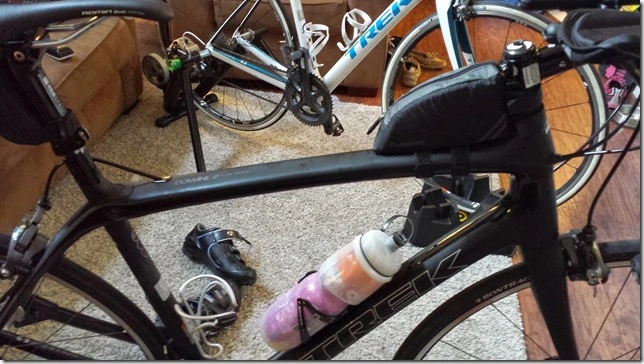
You can just make out the seat tube and top tube connection. You probably can notice that the top tube has a notch in it which receives the seat tube. Normally this connection is welded or formed as a single piece if it is carbon fiber.
The last thing Trek included to make the Domane more comfortable was to outfit it with 25mm wide tires. Traditionally road bikes run on 23mm wide tires. For years people have put on 25 and even 28mm wide tires to make bikes more comfortable. The bikes come stock with Bontrager R3 tubeless ready tires.
The bike comes in 5 versions, the aluminum 2 series, the 4-6 series, and the classics edition. The bikes between 4-6 are differentiated mainly by the level and quality of the carbon fiber used to build the bike, and to a lesser extend the componentry used on the bike. For example, the Domane 4.7 is essentially the same as the 5.2 except the frame is a higher quality carbon fiber. The difference between the 5.2 and the 5.9 is the shifters and brakes, while the 5.2 is Ultegra, the 5.9 is Dura-Ace or SRAM RED.
The standard wheel up until the 6 series is the Bontrager Race TLR aluminum clinchers which are the lowest Bontrager road clinchers available. This wheel is fine (and I still ride it) but Sarah did upgrade to the Race X Lite TLR wheelset when her original wheels were bent out of shape. The upper model wheels area bit lighter but what sets them apart are the DT Swiss hubs. These high quality hubs lead to a smoother ride and possibly a few less watts needed to push the bike. For those who don’t know, the hub is the part of the back wheel that prevent the pedals from turning when the back wheel turns. Then, when pedal, the hub engages the wheel and transfers power in the form of torque to the wheel. DT Swiss hubs have a distinctive click click click when they are rotated freely.
Having ridden a bunch of miles on these bikes we are no less happy with them now than when we bought them. The new bike smell is gone but we still love them. The frame is comfortable and responsive and the isospeed system works without compromising the stiffness of the frame. This is something hard to describe so I wont, go to a bike shop and see for yourself.
Configurable Items – Drivetrain
The Shimano 11 speed ultegra drivetrain is excellent. You might not notice much of a difference between the 105 and ultegra cassette shifting, but you will notice the crank shifting is much better. Plus, one more gear is nice. The price difference between the 4.7 and 5.2 is not extreme, go with the higher quality carbon plus ultegra or save your money and get the 4.3 with the 105 group. The brakes and crankset are both ultegra, making it a full ultegra group. A lot of manufacturer will claim ultegra but put a FSA crank and/or FSA brakes mixed with ultegra components. Trek doesn’t do that on the 5.2, and it is nice.
Wheels
The stock wheels are fine and the upgraded wheels are very fine. I would buy the Domane 5 series and buy the upgrade wheels (keeping the old ones for spares/trainer wheels) before I would spend the money and buy a 6 series that comes standard with the higher end wheels. I would not bother with carbon aero wheels. I would also not bother with Shimano, Mavic, DT Swiss, Zipp or any other brand unless you are getting a really good deal on them.
Tires
If you are like my friends the first thing you do when you get a new bike is to swap the tires out with something like Continental Gatorskins which have decent flat protection. Don’t do this. The stock R3 are 120 TPI (threads per inch) while the Contis are only 170, so not a huge difference. Gators are notoriously hard to get off the rim and while they are flat resistant, I have seen at least 4 flats on gators. The R4 tires with 220 TPI is the next logical choice. Keep the 25mm width. You could go wider, but I would not go narrower. In fact, even if you rent a pair of race wheels, run 25mm (if you can) on the race wheels. You won’t regret it.
Saddle
The bike comes with the Bontrager Affinity saddle but you should be riding a custom fit saddle on any bike you ride. So go get one. Cobb, Specialized, Fitzik, ISM, whatever.
Handlebars
The handlebars come stock with a padded material on the top of the bars which are designed to make it more comfortable to grip. And it does, I wouldn’t mess with this at all, it is one of the things that make a Domane a Domane. I was researching this before I did it and I could find very few instances of Domanes with aero handlebars. So I did it, and it worked fine.
Here is Sarah on her Domane in the aero position. 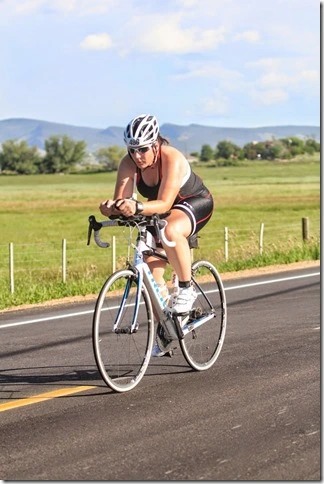
This position is comfortable enough to ride in for 4 hours or longer, so the answer is “YES” to whether you can or should use aero bars on the Domane.
Electronics
The only thing of note here is that the chainstay has a built in compartment which fits the Bontrager Duo-Tap compatible cadence counter. It is compatible with Garmin devices and it is nice to have a cadence counter that isn’t strapped to your chainstay.
Riding Fast
This bike is more than capable of keeping up with the Madone or the Cervelo R series bicycles. Trek makes a big deal out of it being comfortable (which it is) but don’t mistake it for being a slouch. It is an excellent all around bike, comfortable on the flats and hills. It is is a little heavier than the comparable Madone because of the isospeed technology but I doubt anyone would notice. If speed is paramount and comfort secondary, you could buy a “Classics Edition” Domane which is a little more aggressive and totally customizable. Even in stock form, I regularly ride faster than people on racing road bikes and TT/Triathlon bikes. What holds me back, and what would hold you back, is your fitness, not the bike.
Conclusion
If you walk into a bike shop and you are ready to purchase a serious bike and you happen to be in a Trek dealer; they will probably nudge you to this bike. This is because, while it is extremely high quality, it is much gentler on the rider than the Madone. A bike shop will figure that they will get fewer complaints if they sell a gentler, yet still excellent bike, to the general public. At $3600 USD, the Domane 5.2 is a serious bicycle with a serious drivetrain to match. Casual and serious riders alike will be able to take advantage of this bicycle’s capabilities.
Trek is a company people love to hate. People who have Treks love them. People who hate Trek tend to hate them for one of two reasons. 1) Trek is huge and a ton of people around the world ride them. Or 2) They had a Trek that had problems or serious customer service issues with the dealer. Number one isn’t an issue, that is like complaining that every rich guy has a Mercedes. Yes, because Mercedes makes a nice car. Number 2, I know of two instances where Trek or a dealer went above and beyond to satisfy a customer. In one example, a dealer mis-priced a Trek SpeedConcept $2000 less than MSRP. The dealer agreed to sell the bike at the discounted price. In another scenario, someone bought a Trek Madone second hand and they soon had issues with the frame. Trek replaced the frame and this didn’t fix the issue. Trek decided to replace the frame with the current and next model up for the customer, which resolved the issue.
Should you buy this bike? Probably.
Can one bike do it all?
I really like talking about the bike portion of triathlon for two main reasons. First, I really enjoy biking. When I did the Boulder Sprint last weekend I gave up a chance to do the Elephant Rock Gran Fondo which is a lot of fun and I was disappointed. Secondly, the technical nature of the bike is something that appeals to me. We aren’t just working out, we are operating a machine with nuts and bolds and sprockets and pieces etc. All of those come to together (along with the athlete) to produce an athletic result.
I have talked before about tri bikes vs road bikes and I have talked about how Sarah and I got fitted on the tri-position on our road bikes. I like to draw this contrast because even though a tri or TT bike looks so much different than a road bike, a lot of those differences are of questionable value to the average triathlete. This brings up the question then, can one high quality bike do both triathlon and a Gran Fondo like Elephant Rock?
Lets start with a comparison of sorts between two riders at last weeks sprint with a focus on body position relative to the wind. I focus on this because the human body is the largest aerodynamic drag on the bike, by a wide margin. Getting the body into a more aerodynamic position is the most critical aspect of an effective TT/triathlon position.
The rider on the left is Kaira, a friend of ours and fellow triathlete, who is riding the Quintana Roo Kilo. On the right is Sarah, on a Trek Doman 5.2 modified with a pair of tri bars and a Retul fit from Colorado Multisport. We are looking for an aerodynamic body position, that is, how low can you get into the wind. From these pictures, which are not the best, you can see they are very similar, but Kaira appears to have a slight advantage. Sarah looks like she is riding a little taller on the bike, but not that much taller.
Other than the seat position the Q-Roo has an aero bike frame and an aero seat-post. Neither bike has race wheels and neither rider is wearing an aero helmet. On the topic of the seat post, a lot of things mentioned right below the aero cockpit when you read an advertisement for a Tri bike is the seat post angle. It is said that the tri angle helps “save your legs” for the run. Maybe this is true but for comparisons sake it is worth pointing out that the Trek seat post was adjusted in such a way to simulate a Tri seat post.
Looking closely at the pictures you notice that the riders’ knees are coming close to their elbows and handlebars but not too much so that comfort is compromised. The Q-Roo Kilo is known for its comfort in this regard. When you compare these two bikes, both can do triathlon. The Kilo can do a Gran Fondo because if Kaira has to get on the “horns” when being in aero is illegal (as it is in many group rides if you are within a couple of meters of other cyclists) her comfort will be OK. For Sarah, she can just take off the tri bars and go back to her road fit for the Gran Fondo, or keep them on depending on preference.
From the softer end of triathlon bikes, the difference between them and road bikes with aero bars is fairly minimal and as a result either bike can competently wear either hat. Either bike can be specced up with race wheels for serious racing. The Trek obviously can’t change it’s bike frame or seat post design but (as we will discuss in a later post), those two things are surprisingly less important than one would think. In fact, an aero seat post gives you about as much aero gain as holding your pinky finger out has in drag gain. That is to say, there is not much advantage to an aero seat post!
Now, for fun, lets look at the top end of road and tri bikes. Since engineers know that the human body is the biggest drag creator, they get extreme. Lets look at Fabian Cancellera, the famous Swiss time trialist, on his Trek Speed Concept.
His body is a good bit lower than Kaira or Sarah. His legs could probably smack his elbows. The top tube is so short that his elbows rest at a 90 degree angle when in the aero position. It is nearly impossible to duplicate this on a road bike because even the top end Trek Madone can’t get a rider into that position. Sure, you can drop the body lower and raise the seat but the top tube is too long, the rider would be crunched down too much and you wouldn’t get a good position on the aero bars. The fit on the top end Madone or Domane would look similar to the mid-range Madone or Domane. However, the top end Speed Concept is much more aggressive than the Q-Roo Kilo.
Time trialing is a little different than triathlon and the fit is a little different. Lets look at an ironman on a Speed Concept. 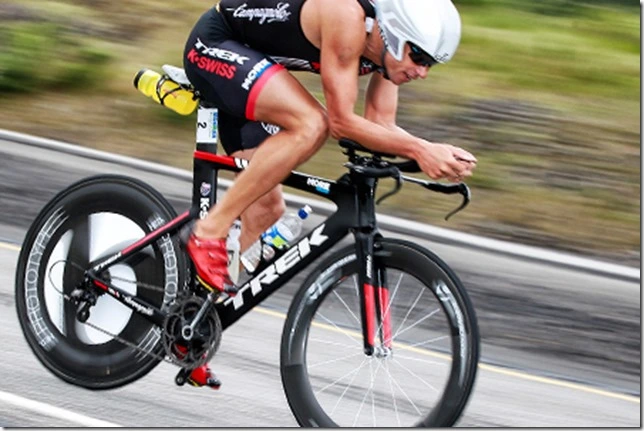
The body position is similar, and from this angle you really get a sense of how far forward the body is on the handlebars. His elbows aren’t as perfectly angled as Fabian’s, this is either by design or, since Fabian is a Trek sponsored athlete, he got a more perfect fit.
Obviously the Trek Speed Concept works great as a Triathlon or TT bike but would you take it on a Gran Fondo? Well, you could, but you wouldn’t. Primarily because in a GF it is against the rules to ride in aero around other riders – if it is allowed at all. If you are in a competitive GF, the officials will penalize you for breaking that rule, it is a safety issue. Riding a bike that is that aggressive on the horns is inefficient aerodynamically and, as people have told me, not comfortable at all.
At the top end of the TT/Triathlon scale, road bikes can’t compete. Similarly, top end road bikes are really no better (maybe even worse) with aero bars than mid-tier road bikes with aero bars. Top end road bikes are clearly more appropriate for a GF or really any time a hill needs to be climbed. As the bikes get more expensive, they actually get less flexible. There is actually a point at which buying more actually gets you less bike. In economics this is called the point of diminishing returns. The more you put in, the less you get out.
Let us also not forget that the most important part of the bike is they guy or gal riding it. Fabian on my bike will destroy 99% of the field of any triathlon on the bike leg no matter what the field is riding. The most efficient and cost effective way to gain speed is to improve the rider.
Boulder Aquatics Masters Open Water Swims
This morning Sarah and I went out to the Boulder Res to have an open water swim. You can’t just show up at the Res and start swimming, especially not at six in the morning. Boulder Aquatics Masters hosts an open water swim period on Tuesdays and Thursdays from 0610 to 0740 which is plenty of time for training whether you are just trying to improve your fitness or if you are training for a full Ironman or Leadman.
The BAM crew sets up buoys of different colors around the Res and they cut out loops of 500 and 1000 meters. Along with the buoys they have rescue kayaks on the course which you can use to rest on if you are fatigues or have an equipment malfunction. They say the long course is 1000 meters and on my first lap Garmin indicated I had gone .63 miles which is actually 1014 meters. Don’t mistake meters for feet, 14 meters is actually pretty far in a straight line. I attribute that to not taking a direct line between the buoys. On the first lap the sun was cresting the horizon and when I was swimming towards it, it was difficult to see the buoy and I strayed off course. I did two laps which totaled 1.28 miles and that is a good bit of swimming.
The drop in fee is $15 and a 5 use punch pass is $55 which reduces the unit price to $11. The main advantage to the punch pass is that it can be shared between two people.
That might seem expensive for 1.5 hours of possible workout time but a lot goes in to setting this up. They have two people checking people in and out (if you check in and not out they try to find you, anywhere), a couple of guys in kayaks to make sure the buoys are set up and to make sure you don’t drown, and there is 1-2 people on the shore. Then there is whatever fee they pay the res to use the facility.
If you are a burgeoning triathlete looking to gain some OWS experience this is one of the few places you can get that experience safely outside of the triathlon or aquathon. If you are in the north Denver metro area (including, obviously Boulder) you should check it out.
http://www.bamswimteam.org/w/page.cfm?pagetitle=Open%20Water
Boulder Sprint Triathlon Race Report
I have finally gone and done an actual triathlon! For all my training and talking about triathlon, this is the first one that I have ever actually done. A sprint triathlon is a short distance triathlon that attracts everyone from first timers (me), young people (youngest male was 13), old people (there were a few septuagenarians in the group) and some very, very, very fast athletes. This sprint is an Ironman branded event which really doesn’t mean anything significant except that there is a bit of a quality standard that Ironman branded events are held too. This race was a 1/2 mile open water swim, a 17 mile bike, and a 3.1 mile swim. This is slightly longer in the bike than a normal ITU sprint triathlon.
Pre Race
Athlete check-in was Saturday and we were there right at the start because it was a training day so the team decided to do a little workout while the check-in was being set up. Check in was uneventful and the staff was helpful. We attended the athlete briefing which was short and sweet. There isn’t a ton of stuff to go over for a race this size and distance. We didn’t have mandatory bike check in, which nice because I don’t like leaving my bike where I can’t control it. I have a lot of money tied up in that thing.
The next morning Sarah woke me up before 0500 (which annoyed me) to get out to the race location. We didn’t start swimming until 0730 and I hate standing around. We didn’t have to be quite so early but it worked out OK, we ran into a bunch of people we knew and we hung out. 
I am second from the right. Our coach, Nicole, is very close to having that baby! Jason, far left, and Brian, right next to me, are in my age group so they swam with me.
Hijinks ensued when it was time to get into our wetsuits, which caused nerves for me because the last time I swam in the wetsuit (the day before) it felt like I was shoulder pressing the entire time. Imagine those little elastic bands with handles on them which you can find at almost any health club. Imagine stepping on one end and doing the crawl stroke holding the other. This is what it felt like to swim in my wetsuit. I texted Nicole, distraught at the thought that I had made a $700 mistake in buying that wetsuit. Her response; “You have to pull that thing all the way up so that it hurts your nards a little bit”. Okie dokie, hurt the nards, got it. 
Sarah helped me put it on, Nicole was being might helpful holding the camera ![]() . Joking aside, if you notice that the sleeve is a couple of centimeters away from my wrist, the day before it had been down at my wrist, this time we pulled it all the way into the shoulder to give my arm more freedom…and we pulled it all the way to the nards.
. Joking aside, if you notice that the sleeve is a couple of centimeters away from my wrist, the day before it had been down at my wrist, this time we pulled it all the way into the shoulder to give my arm more freedom…and we pulled it all the way to the nards. 
Nicole took a break from the camera and helped me a little more before striking a pose with me. Some other triathlete was letting his daughter get in the water before daddy went off to do his swim. 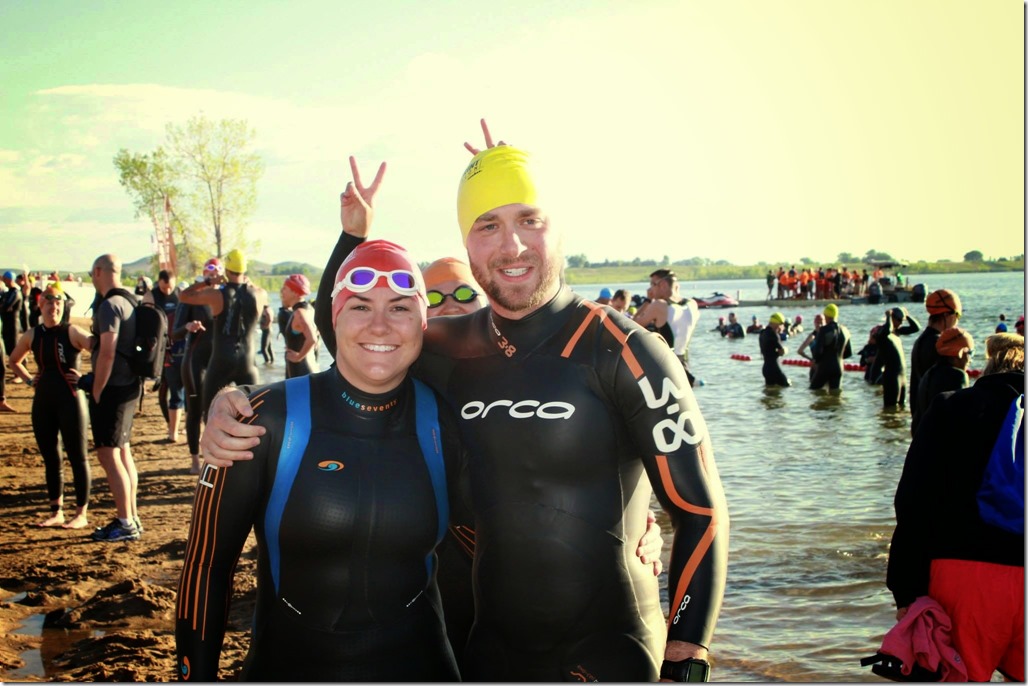
Bunny ears as a good luck charm to the Sullivans!
Something about being wrapped up in a bunch of rubber makes girls go a little nutty. 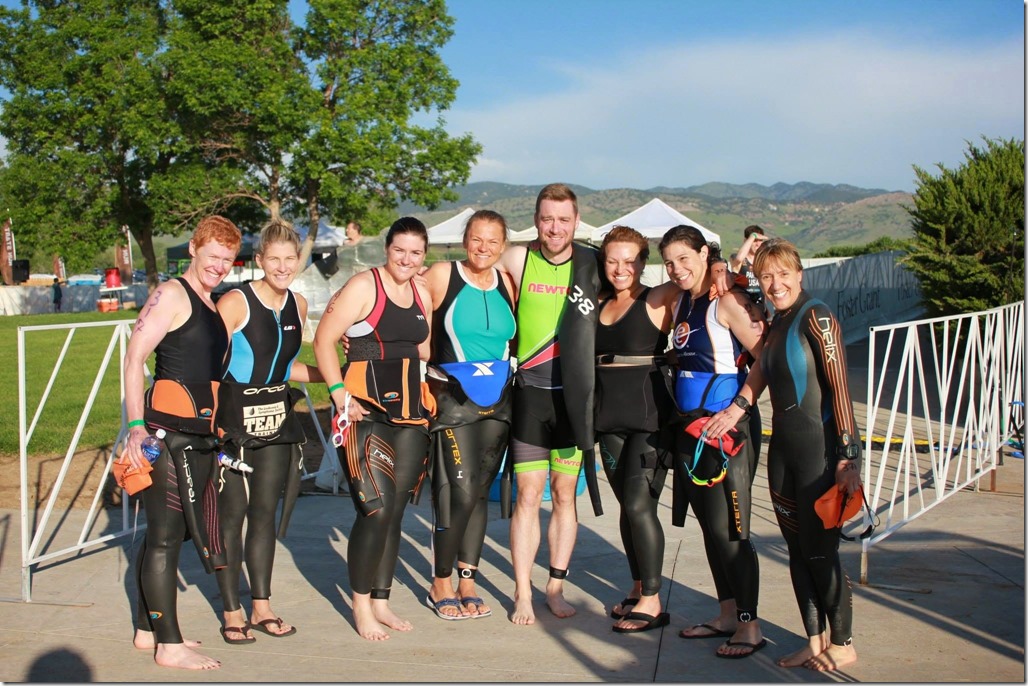
The ladies got into their wetsuits much earlier than I did, I have a superstition about things and I don’t like getting my equipment on until I am absolutely ready to start doing whatever activity I am about to start.
The Swim
Unlike last year, when Ironman races did a metered start, this year they are doing wave format starts. I was in the first wave, males from 12-34 years old. We started in the water about waist deep. The course is a U shape with three buoys on the long sides and one on the short side. The starting noise went off and we were into the race. A triathlon swim is hard to describe unless you have done it. Unlike the pool, you have little to no directional reference looking down or ahead in the water. You have to spot the buoys and set a course and hopefully you stay on it otherwise you will stray. This is easier when you are with a bunch of people because the pack tends to go in the right direction. As much as it was annoying swimming in the pack, when I found myself not around anyone, it wasn’t because I was going wicked fast, I was actually off course. I probably lost a minute or two over the course because I had to change direction to get around the buoys.
Fortunately the adjustments in my wetsuit helped though I was still swimming with more resistance than I am used too. This may be just a consequence of swimming with a full sleeve wetsuit. I had no idea, I am such a novice that I just got a wetsuit that someone told me I fit into and went from there. Doing it again I would go with a sleeveless wetsuit. The water is not cold enough to phase me and unrestricted arm motion is more important to me than getting slightly more hydrodynamic with rubber covering my arms. People make a big deal about how much their wetsuits “help” them, primarily with buoyancy, to me it feels like more of a hindrance. Then again I don’t have issues with buoyancy in the pool, so it is solving a problem I don’t have and introducing problems of its own.
At any rate the swim didn’t go badly. I got in at 14:04 right before my two buddies in my swim wave. They passed me going up the chute to T1, I was a little dizzy from the swim so I didn’t go too quickly into transition. 
I am looking a little winded but I am doing fine, I got over the vertigo from being in the water by this point. 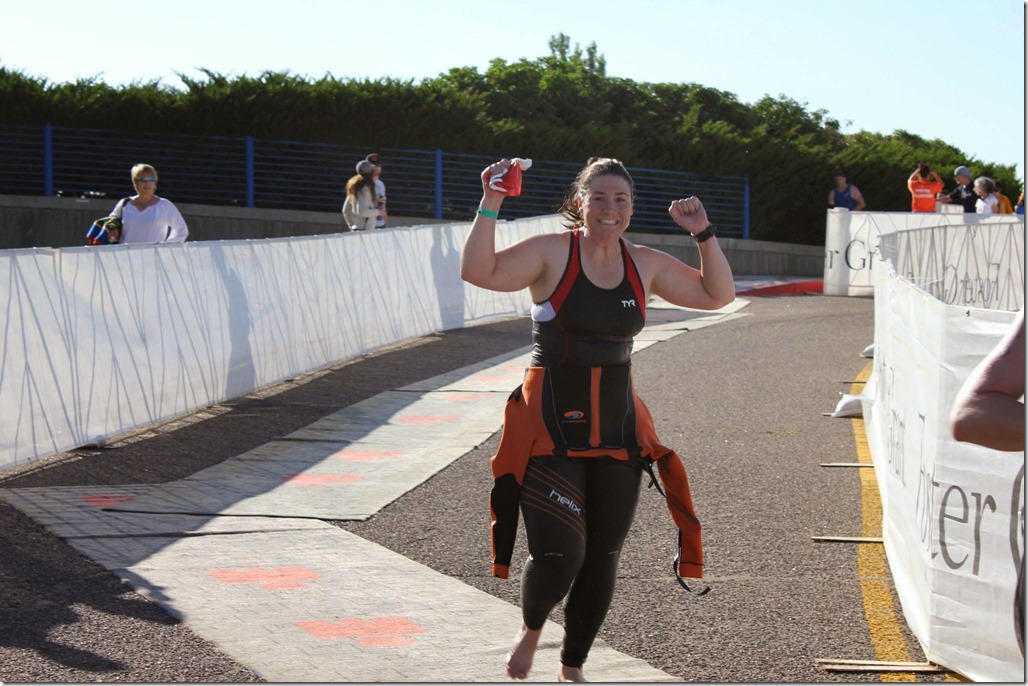
Sarah is a more experienced triathlete and open water swimmer than I am. Getting out of the water and into transition was less dramatic for her.
The Bike
It took me 2:47 to get out of T1, probably a whole minute of that was peeling off the stupid wetsuit. I got that thing off and shoes + helmet on and I was ready. It sucks to run in cycling shoes. It is like running in ski boots, awkward, slow, and noisy. 
For a 17.1 mile bike ride I would be on my bike for less than an hour. Only one water is needed for that so I went without any additional bottles on my bike frame.
I had a good and strong bike, 21.6 mph and I finished in 48 minutes. I know this course well and there is a grinding uphill portion for the first 5 mile stretch. Even when you start going downhill you are still kind of going uphill at the same time until you hit Neva road where all of that work gets rewarded with almost constant downhill until you get back to the start.
I got a two minute penalty on the bike for “overtaken”. In triathlon rules there is a rule that says once you get overtaken you need to drop back a certain number of bike lengths in a certain amount of time. I did not do that and I was penalized. In a longer race this might result in going to the “penalty tent” for the prescribed amount of time, in this case the penalty was added to my total time. This only really matters if you are competing for money, age group awards, or to go to a world championships. None of those apply to me so I am not so broken up about it. I knew the rules and I got dinged, I will be more careful next time.
Due to my decent swim and good bike, I got in off the bike with a lot of serious athletes. My T2 time was much better (1:37) owing to the fact that all you really have to do is take your helmet off and change shoes.
The Run
A 3.1 mile is a little baby run compared to most triathlons and open running events. At the end of a triathlon, even a sprint, the run can be an unforgiving mistress. I set my pace in the high 8 minute miles (and I stayed there) and I was passed mercilessly by what seemed like everybody (it wasn’t everybody, but it was probably 130 runners). It wasn’t that my run was terrible, it was that I was in with all the very good athletes and compared to them, my run is very slow. I am talking about sub-20 minute 5K times. I can’t do that fresh.
I did the run in 27 minutes and change, which is actually a quick 5K for me. I am bulkier in the upper body than most triathletes owing to the 10 years of weightlifting I did before this sport. That extra weight does me no favors at any portion of triathlon.
Sarah did a personal best on her 5K and came in about ten minutes after me. 
Overall I placed 145 out of about 470 competing athletes and the upper half of my division and gender. This was a competitive field so while I would have liked to have paced better, the only conceivable place to do that was the run, and training to do a 1/2 marathon in a 70.3 is different than training to do a fast 5K. Maybe after the 70.3 I will put some more effort into my speed, but at this point I am happy with where I am at.
Now for the 70.3
As a predictor of my performance on the 70.3 I am OK with my results and how I felt. I felt like I could easily continue running for another 10 miles. Obviously I will approach the 70.3 much differently than the sprint. I will have to do a much better job sighting the buoys and I will plan on spending at least 40 minutes in the water so the vertigo will be more pronounced. I will go probably 2-3 mph slower on the bike than I did on the sprint and I will be between 3 and 3 hours and 10 minutes on the bike. I will start the run at a 10 to 10:30 pace instead of blazing out of transition as fast as possible. The half marathon will take anywhere from 2 to to 2 hours and thirty minutes – maybe more. Fueling will be much more important, I had one bottle on the bike and I took two cups during the run. During the 70.3 I will have three bottles (or more) on the bike and almost every aide station I will take some water. I will have a bonk breaker, gummies, and a gel on the bike. At the beginning of the run I will have an EFS power shot and 1-2 gels over the 1/2 marathon and possibly another bit of bonk breaker.
I am a little more confident now that I have done the sprint, but I am still wary to “respect the distance” on the 70.3.
